Though we send brand invites for our annual Gear Test Week in February and have finalized submissions weeks before arriving at Powder Mountain, trends in a season’s lineup don’t become clear until well after the test. It’s only when us editors begin parsing through testers’ first impression scores, reading through forms and sifting through the compiled specs for every ski, boot and binding that a bigger picture emerges.
While years past have yielded a concentration of mid-range skis—the type that strive to be quiver killers—our latest test marked a shift toward ends of the spectrum. This doesn’t mean a loss of versatility but rather a slew of setups which cater to the preference of the person driving them. There are lightweight carvers which power through crud and playful, wide-yet-light chargeable skis; three-buckle, 130-flex, 2,500-gram boots and their freeride counterparts with a Boa, two buckles and a proprietary spine which allows surprising ROM; and 15-RV equivalent, 790-gram tech bindings and those whose tech toe can be replaced with a Pivot. The adventure is yours to choose. —Greta Close
Categories
Free Tour: Progressive flex and inbounds performance with a walk mode.
What these boots lack in range of motion, they make up for with true 120-plus flex ratings, alpine-binding-compatible soles and adjustable forward leans.
Dalbello Cabrio MV Free 120 IF
dalbello.com | $700 | 3,960g | Flex: 120 | Last: 101mm | Sizes: 24.5-30.5
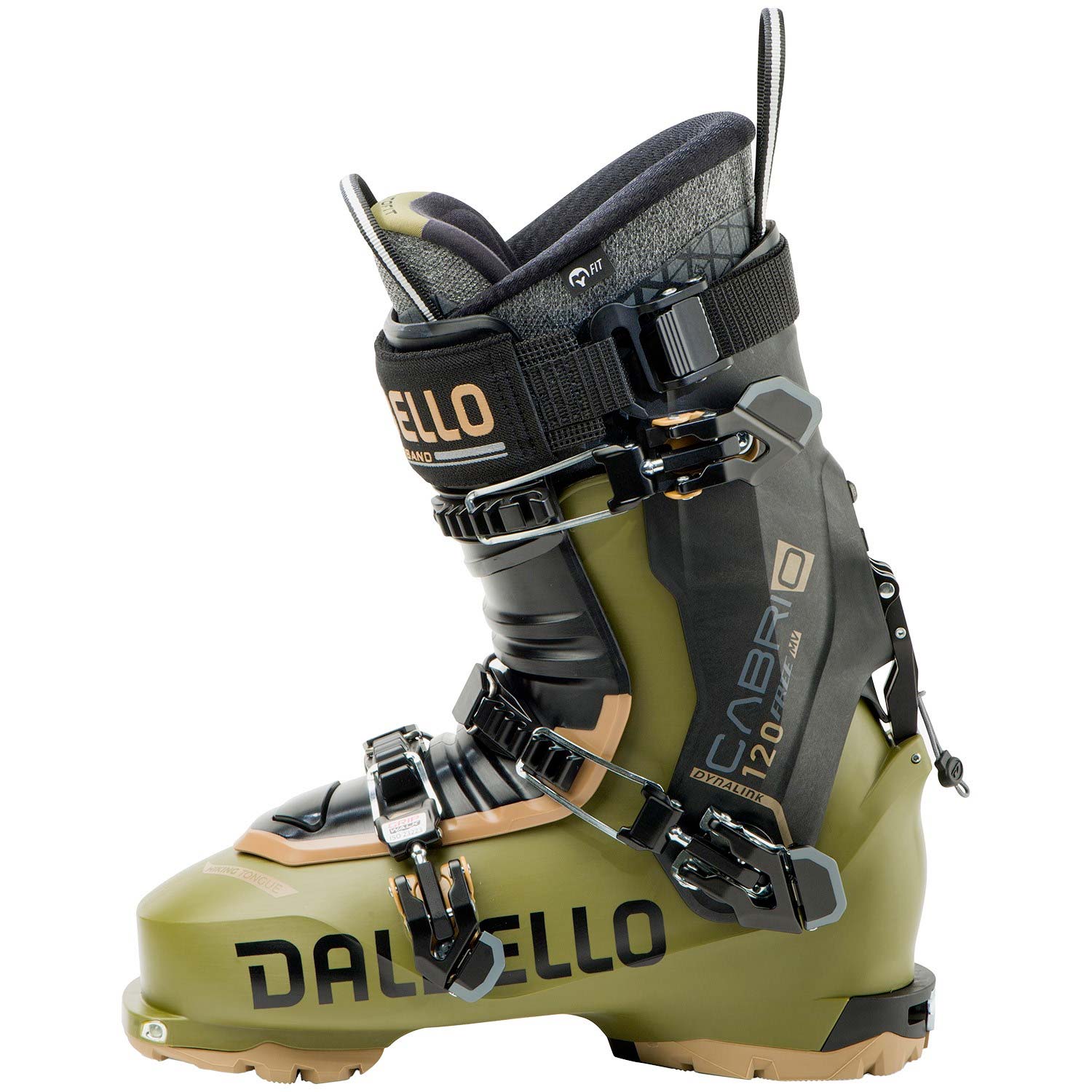
“For short or long walks to terrain where a solid and powerful boot on the descent is important,” said a freerider of the Cabrio MV Free 120 IF, part of Dalbello’s new mid-volume line of three-piece freeride touring boots. The bi-injected Pebax tongue has softer plastic in areas prone to bending the most in walk mode, yet it still offers ample support on the downhill. “The tongue provides that progressive feedback that the best three-piece alpine options are known for,” said a tester well-versed in touring boots.
Solid downhill performance may come at the cost of uphill mobility. A veteran skintrack crusher gave the boot high marks in all categories except walk-mode range. “This heavier boot is comfy, with a plush feel that babies your feet on the way down,” he said. “It does not baby your quads on the way up.” Nonetheless, he added that “the thick liner with well-designed tongue makes this boot a pleasure to wear for long days.” The freerider agreed on the fit, saying, “The liner of this boot wraps the forefoot well with an autofit tongue that comfortably curves to the shin contour.”
Also enhancing fit: The middle buckle (of three) is affixed to the polyamide composite shell’s ankle pivot point to maximize heel hold, says Dalbello. One ex-racer who prefers beefier boots noted, “The instep buckle has a lock feature that works well unless you are maxed out on the buckle ladder.”
“If you have a big, wide foot and love lift service to take you 90% of the way, with the last 10%
being a boot pack, this boot is for you.” —Darrin MacLeod
Salomon Shift Alpha BOA 115 W
salomon.com | $850 | 3,340g | Flex: 115 | Last: 98mm | Sizes: 22.5-27.5
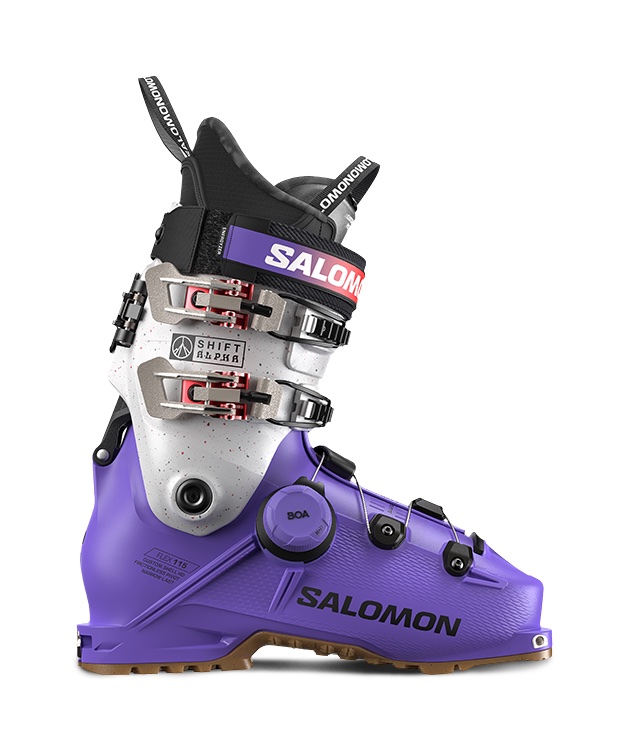
Salomon got creative with their latest addition to the freeride-focused Shift line: the Shift Alpha Boa boot. “The downhill performance is hard to beat,” said a Wasatch brunette. “Capable for the resort and strong, but you’d be happy in them for a shorter backcountry mission,” added her blonde Teton counterpart.
A polyurethane shell and polyolefin and pex recycled cuff incorporate “subtle but impressive design notes,” according to the brunette. Connecting through the shell and cuff where Achilles meets calf is Salomon’s Freespine tech. The rigid plastic wedge rises to within an inch of the top of the cuff, strengthening the rear of the two-part boot, earning the 115 W model a 6/7 score on fore/aft and lateral stiffness from our testers.
An Exobelt stretches from inner ankle bone to upper foot where it meets a Boa-tightened cable. Lines along the shell’s overlap gauge tightness, while an adjustable tongue allows additional customization for this midvolume, midwidth boot, per testers.
For the skintrack, a simple door-like tab detaches the cuff from the Freespine. “Range of motion isn’t great,” said a tester of the claimed 55-degrees, “but it improved with use.” For sidecountry laps
and shorter tours, she was fine to sacrifice some walkability, saying, “This boot can ski!” “Super fun on the descent and feels built to charge,” echoed another.
“Those who value downhill performance will likely think the weight is worth it for the performance payoff.” —Katie Cooney
Lange XT3 Tour Light 130 MV
dynastar-lange.com | $1,000 | 2,900g | Flex: 130 | Last: 99mm | Sizes: 24.5-29.5
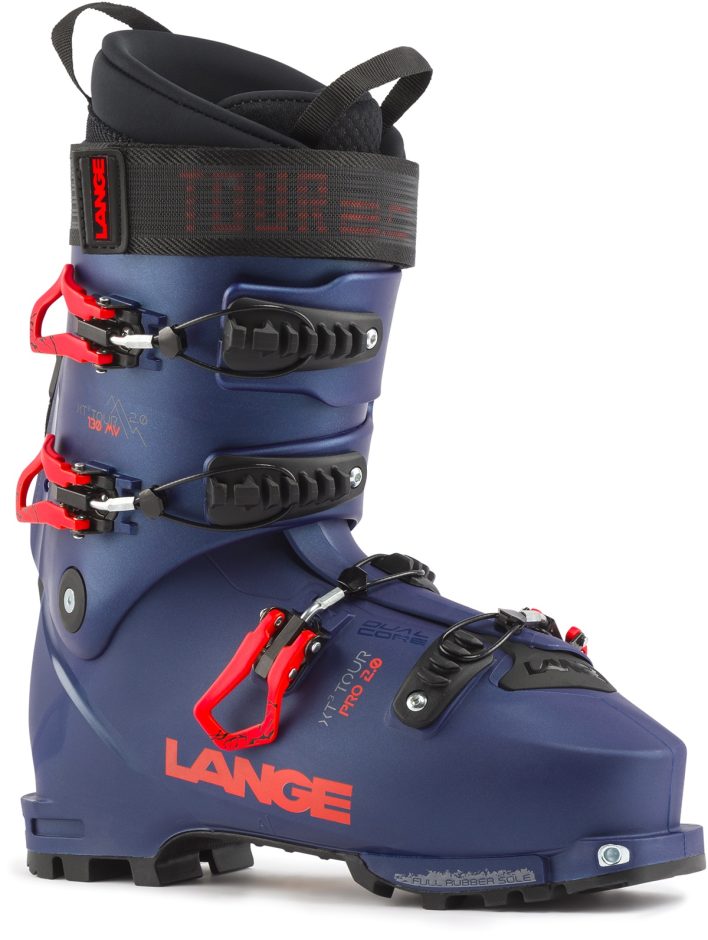
The most recent iteration of the Lange XT3 Tour retains the essential Lange-ness while sharpening its touring ability even more. “The magical minds at Lange cracked the code on a killer ski boot that walks better than it should,” wrote a Tetons-based tester.
Like the first version of the XT3 Tour, it combines a four-buckle feel with touring capability. “For everyone who loves Lange,” wrote a veteran tester, “completely reliable and refined.” This latest version shaves 100
grams by replacing the more traditional aluminum buckles with a lighter-weight cable/buckle hybrid mechanism. Lange kept the tried-and-true Lyfran construction and V-lock mechanism, which, per the brand, connects the lower shell and cuff just like an alpine boot while in downhill mode.
The XT3 comes with a touring sole capable of pairing with multinorm compatible bindings. The walk mode locks the cuff with an internal piece which connects to the lower. This delivers enough power transfer to drive a stout ski and allows a 53-degree ROM. Inside the boot, one tester noted, “The liner was thin and super spongy.”
While not having the ROM of light-weight touring boots, the consensus among the testers was that its weight-to-skiing ability ratio was on point. “The XT3 Tour should be matched with a heavier more robust
AT binding and a solid all-mountain ski for the resort until the time is right to head out into the sidecountry,” wrote one tester.
“If you love a 50/50 boot but want to walk further without sacrificing much at all, this boot feels like an
inbounds boot!” —Ian Halderman
Sport Tour: At home navigating steeps, wiggling pow and everywhere in between.
Despite a generous range of motion and minimal weight, these boots can still drive a 110-underfoot ski thanks to creative buckles and a medley of materials.
Scarpa 4-Quattro Pro
scarpa.com | $949 | 3,110g | Flex: 130+ | Last: 100mm | Sizes: 24.5-33
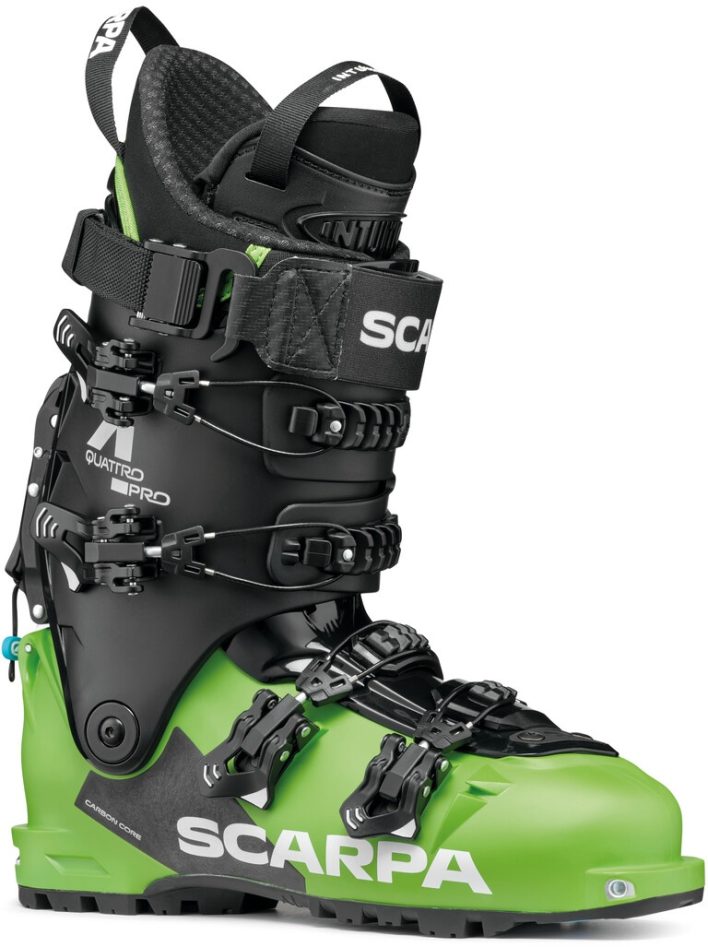
The Quattro line both tours well and is capable of driving frontside skis. The Pro keeps that backcountry capability while sharpening its in-bounds performance. Only 55 grams heavier than last year’s EC winning 4-Quattro XT, the benefit of that weight is a flex rating of 130+ compared to the XT’s plain ol’ 130. A tester who has skied Scarpa boots for several years called them an “anomaly of a boot,” remarking
on its progressive, soft-off-the-top flex.
A redesigned cuff incorporates a stiffer back with a lower front, intended to provide more precise power transfer. The liner boasts a plastic-reinforced tongue as well as slightly tweaked construction and the Grilamid shell’s carbon core is replaced by a combination of Grilamid and pebax. “An excellent blend of ski feedback and dampness,” said one tester.
“The ease of use and range of motion of the walk mode exceeded all of my expectations,” said another. The 4-Quattro Pro uses a similar overall design to the more touring-oriented Scarpa Maestrale, resulting in the same 60-degree stated ROM. However, with two aluminum supports instead of one, the walk mode mechanism is sturdier. Another noticeable feature is a lock intended to ensure the boot can’t come
out of ski mode when pushed to its limits. “Pro is actually an apt moniker,” wrote a seasoned Vermont-based tester. “Patrol? Guide? Check and check. Pro skier? Yup.”
“Traditional four buckle with the accompanying stiffness and comfort and one of the best walk modes and range of motion on the market.” —Damian Riddle
Atomic Backland XTD Carbon 115
atomic.com | $1,100 | 2,580g | Flex: 115 | Last: 100mm | Sizes: 22-27.5
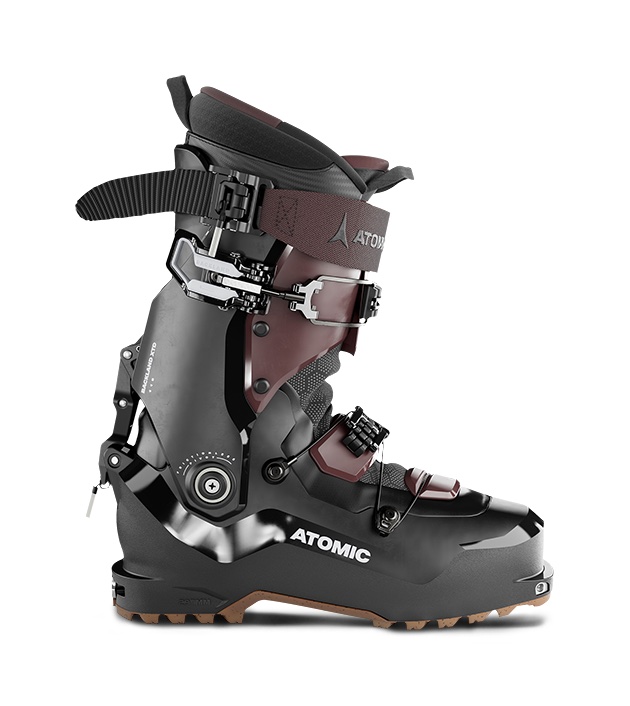
Much to millennials’ chagrin, Gen Z is resurrecting the Ugg boot. But, per one high school senior, this Backland is better: “I’m currently sitting inside and chose to keep these boots on versus putting on my Uggs. That’s just how great it is.” An elder millennial added that, unlike her old unsupportive Uggs, these “felt wonderful to walk uphill in.”
While the liner might not be fleece-lined, testers did award it a 5/7 for quality and warmth, an unusually high score for such a tourable boot. Additionally, they were impressed by the cable buckle on the forefoot, which evenly distributes pressure on a variety of foot shapes and locked the heel into place. “I don’t need to unbuckle them on the lift ride up,” said one satisfied tester. She also kept that lower buckle
fastened on the skintrack. A back lever can be opened for a claimed 74-degree ROM, achieved by ditching the tongue in favor of a waterproof gaiter over the ankle.
Missing that piece of the boot might seem like a recipe for downhill disaster, but the wrap-style polyamide cuff is backed by a carbon spine on the rear, which connects to more carbon-infused polyamide in the lower shell for a progressive flex. “This is an uphill boot but has enough body to feel good for the down too,” said our elder millennial. Her Gen Z counterpart, who competes on the youth freeride circuit, added, “If I were to get a boot that I could use skinning and in a resort, this is the boot I would get.”
“It felt like a dainty slipper but slayed the downhill unlike other boots in its class.” —Bria McCurdy
Tecnica Zero G Tour Pro
blizzard-tecnica.com | $899 | 2,578g | Flex: 130 | Last: 99mm | Sizes: 24.5-30.5
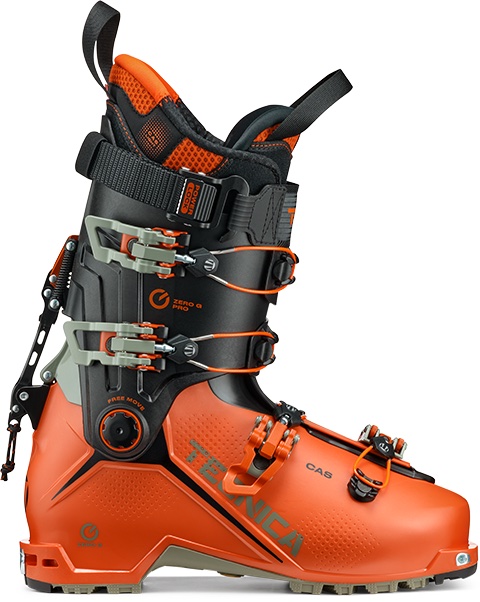
The redesigned Zero G Pro boasts 10% more range of motion in walk mode and is 200 grams lighter, but testers were more focused on the downhill performance, with two testers comparing it to Tecnica’s freeride-focused Cochise line.
Ironically, tech borrowed from the skimo-inspired Zero G Peak enhances the ski quality, namely the Power Frame Construction and the Double Blocking walk mode. Co-injected bands of Grilamid (forward) and carbon (back) connect the ankle’s pivot point to the walk mode, where the walk/ski lever is anchored to both the shell and above the cuff hinge for a more progressive flex, per Tecnica. “The newly designed lower cuff now incorporates lateral carbon stiffening bands that completely resolves the rotational waffling of last year’s,” said a tester who has lived in the Zero G line since their 2019 release.
Tecnica raised the bottom of the Grilamid cuff to allow for a longer forward stride and a higher instep. “The fit is slightly roomier for those whose insteps were limited in the old Zero G,” raved a Montana boot nerd. Along with the adjusted instep, the stock liner averaged a 6/7 and the toe box is wider, which made one sensitive-toed tester say, “This boot fit my medium volume foot with no adjustments needed.” After a longterm side-by-side test with last year’s model, a ski guide deemed, “In tour mode, nothing was that different. It still walks really well for a four-buckle boot and didn’t sacrifice anything for the increased stability.”
“I was impressed with the rear and lateral stiffness. It skis almost like a Cochise, but tours like the classic Zero G.” —Mike Parri
Speed Tour: The überlight gear best for Type III fun.
Skinny skis and no-buckle boots dominate this minimalist category which is just as at home on the skintrack as it is in your local skimo race.
Head Crux Pro
head.com | $950 | 2,500g | Flex: 130 | Last: 99mm | Sizes: 24.5-30.5
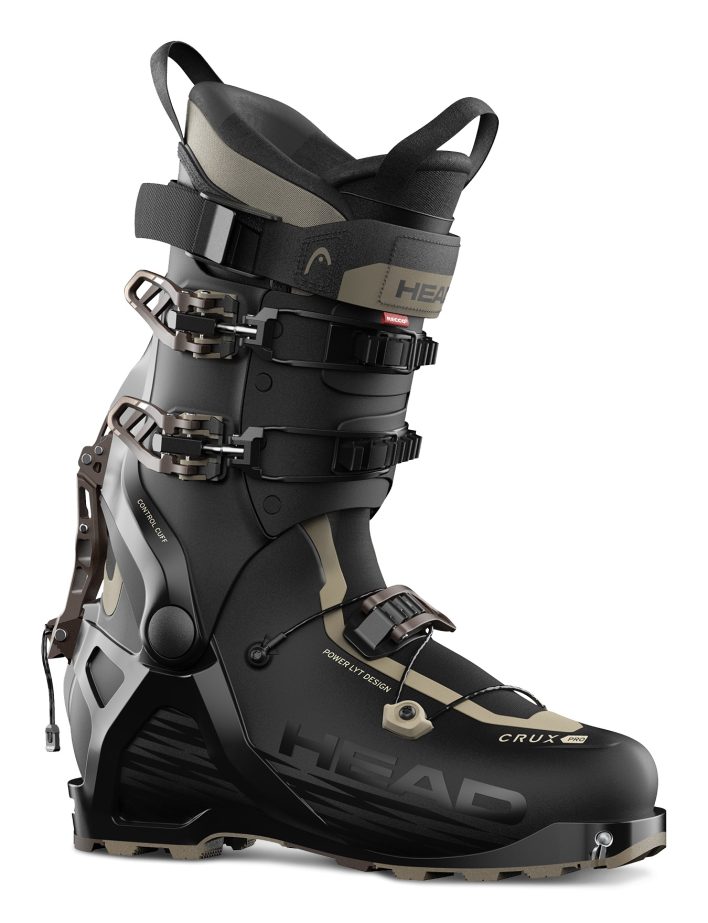
Head has entered the touring-specific boot chat. Our testers response: high scores in fore/aft stiffness, walk mode, snow feel and ease of use. “No noodle ankle here!” exclaimed one Teton charger. “Responsive and solid,” added another tester who spent last season exploring B.C. on skis.
A true sum of its parts, the Crux Pro features a Pebax Rnew and recycled carbon fiber shell, creating a strong and stiff outer layer. Stiffness and skiability are heightened by a high-profile cuff with two buckles to secure it, plus a ratchet power strap. Head’s Lyt (proprietary term for their carbon-infused plastic) frame links the boot, cuff and walk mode lever, helping to solidify the multi-part hinge. “Extremely stiff off the top,” one Teton tester who seeks speed and airtime said. “I did not overflex this boot once.”
On the foot, a single buckle tightens a cable which crisscrosses from toe to ankle bone. Testers did find the 99-millimeter last was “slightly narrower than advertised,” but they acknowledged that with some molding and packing the fit could adapt. A standard spring-loaded lever on the heel unlocks the Crux Pro to reveal a claimed 55-degree range of motion for “a fantastic walk mode,” in the words of one free tourer from Tahoe. A tester from the Tetons who tours on a heavy setup did find the heel cuff rubbed on his Achilles, but he was still a fan, nicknaming the Crux Pro “the big boy’s skimo boot.”
“This boot is definitely more focused on the skin, however, it exceeded my expectations with how well it skied.” —Eric Tiffany
Dynafit Ridge Pro Boot
dynafit.com | $900 | 2,500g | Flex: 120 | Last: 101mm | Sizes: 25-30.5
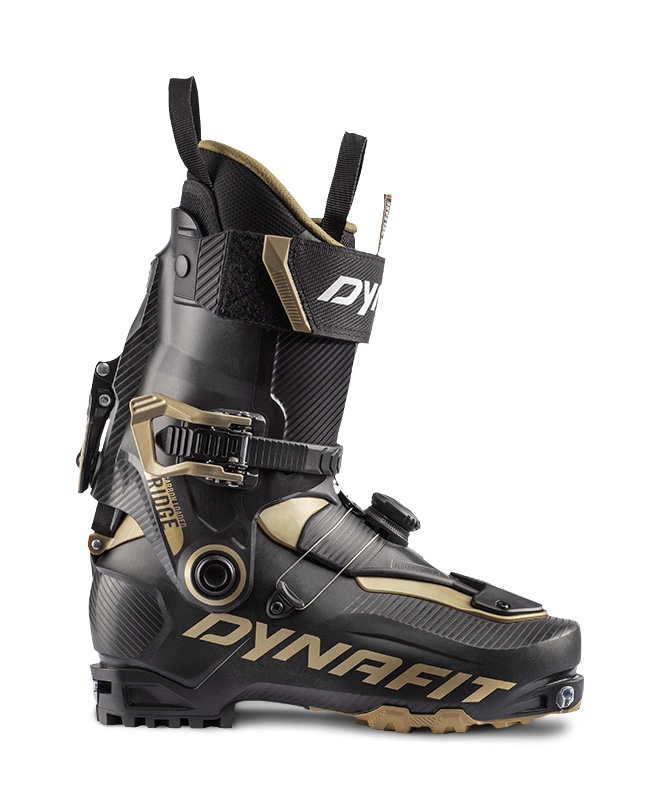
Born from the tinkering hands and engineering brain of Eric Hjorleifson, Dynafit’s new Ridge Pro was built for committing lines. “This boot performed significantly better than my sarcastic mindset wanted it to,” confessed a hard charger from Teton Valley.
Three unique and independent mechanisms fasten this boot’s carbon fiberloaded Grilamid shell and cuff: a Twistfit (a Boa alternative), a buckle and a power strap. “The cable knob lower and cuff lock/cuff cord wrap work well together,” one veteran Bozeman tester with a preference for long tours said. “Precise adjustment, fast transitions.” Plus, a floating tongue enables additional fit customization, benefitting varied insteps according to a Teton shredder.
When it’s time to walk, the Hoji Lock lever system, which scored a 6/7 for ease of use, disengages the cuff, as well as the power strap, “giving massive range of motion fore and aft,” raved a ski coach. Two others described said walk mode as “phenomenal.”
On snow, the Ridge is “light and stiff,” according to our Bozeman sport tourer. Though one tester compared the myriad mechanisms employed to lock the boot down to a Rubiks Cube, the efficacy was hard to argue with. “Built for all day sport touring,” said a Vermonter, adding, “For multiple ascents and fun descents in a day.”
“They walk comfier than your Converse All Stars, transition in 0.5 seconds and have the backbone of a Silverback Gorilla.” —Ian Halderman
La Sportiva Kilo
lasportiva.com | $899 | 2,000g | Flex: 110 | Last: 100.5mm | Sizes: 24-31.5
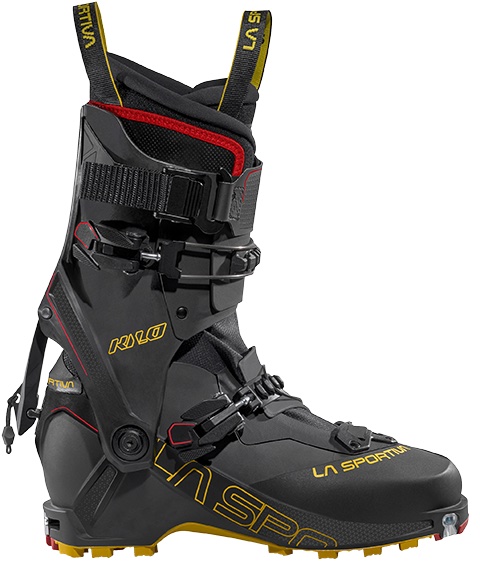
Perspective is a powerful thing. Exactly how stiff is a 110-flex boot? Does your frame of reference change if that boot weighs an even 2,000 grams per pair?
According to one tester, the 110-flex Kilo “surpassed my expectations.” According to a featherweight-inclined tester, the Kilo is intended for a “touring mostly skier who wants comfort and a lightweight but stiff, powerful boot on the way down.” The claimed 70-degree range of motion is thanks to an open front design, covered by a waterproof gaiter. The shell blends Grilamid with carbon to find the balance point between weight, stiffness and progressive flex. “Stiff enough to push a bit,” wrote one tester. Like many other options in the speed touring category, the liner is light, averaging a 3/7. Testers noted that driving heavier skis can result in feeling the shell through the liner.
While fit is subjective, a theme emerged in many testers’ impressions. The minimal buckle system held well but the 100.5 last width tapered in a way that could make contact around the pinky toe. That being said, the Kilo still has the strength to be skied like a true ski boot and not like a featherweight randonée boot. As one tester remarked, “Just enough forward flex so you can really lean into it and drive your skis.”
“This boot is for long days in the backcountry where comfort takes priority, but once it was locked down,
this boot was pushing wide, heavy skis through tricky terrain.” —Maggie McGee
Published here are 9 of 24 ski boots we reviewed in our 2025 Gear Guide. To check out the comprehensive range of boots we wrote about, or to learn about plastics, closure systems and more, pick up a copy of the 2025 Gear Guide, available in print and PDF versions.
*Affiliate link disclaimer:
At Backcountry Magazine, we are committed to providing you with honest and informative gear coverage. To support our work and continue delivering quality content, we are including affiliate links in our reviews. Partnerships with retailers are separate from coverage, ensuring that our reviews remain unbiased. These links help us earn a small commission if you make a purchase through them, at no additional cost to you.


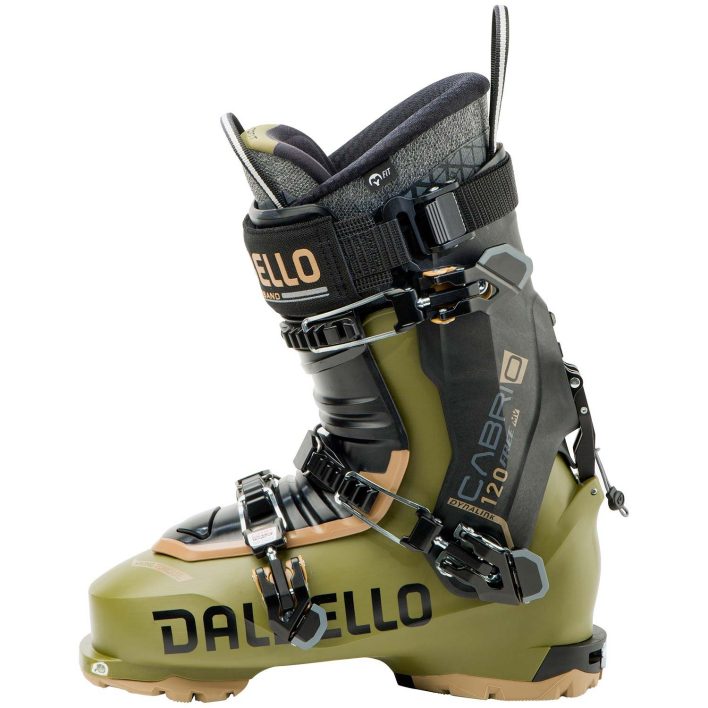
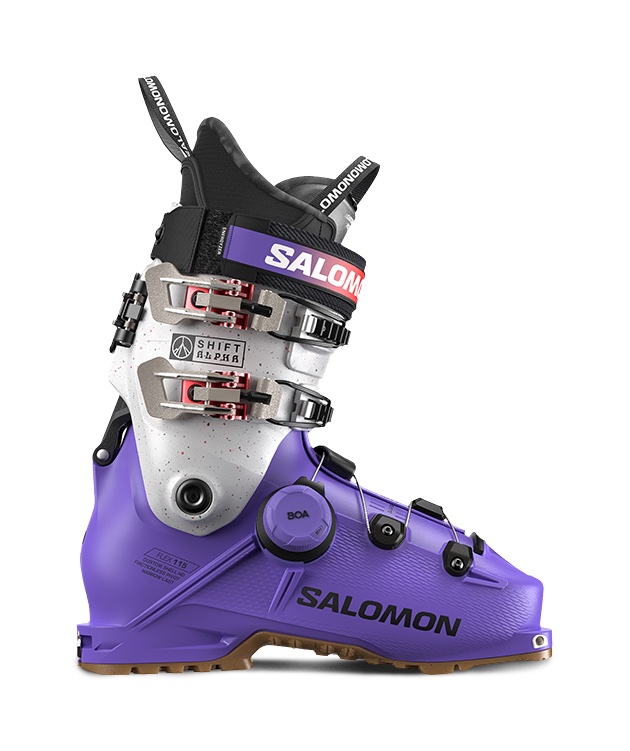
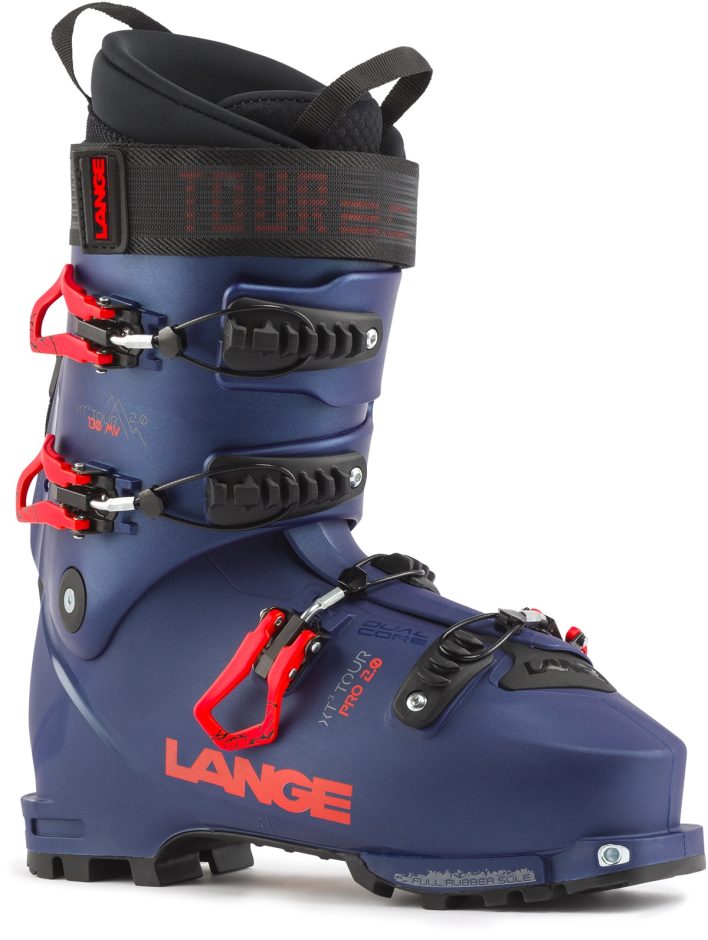
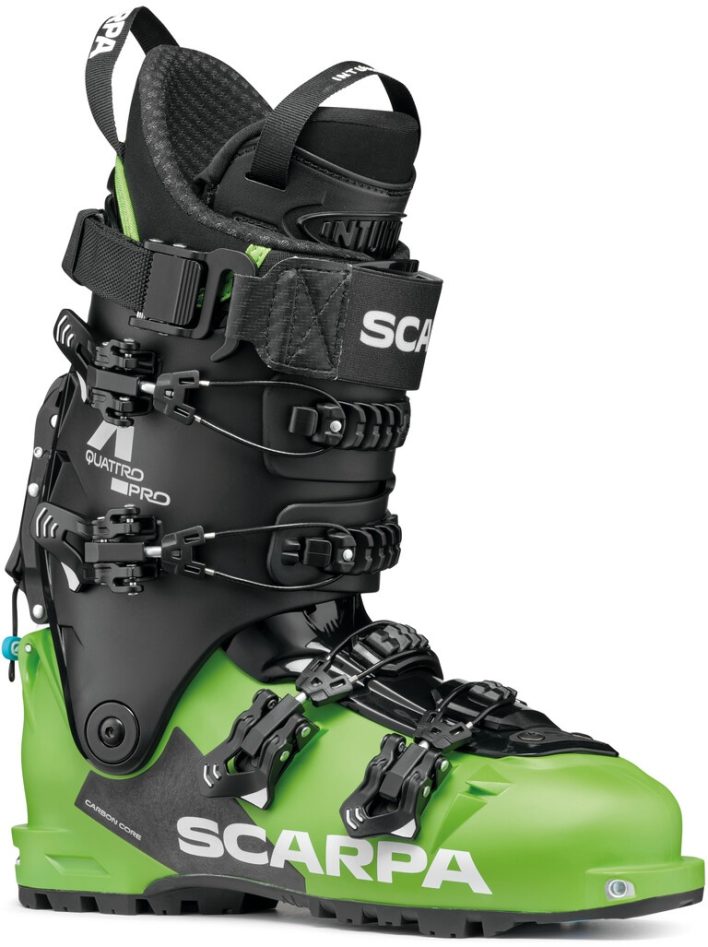
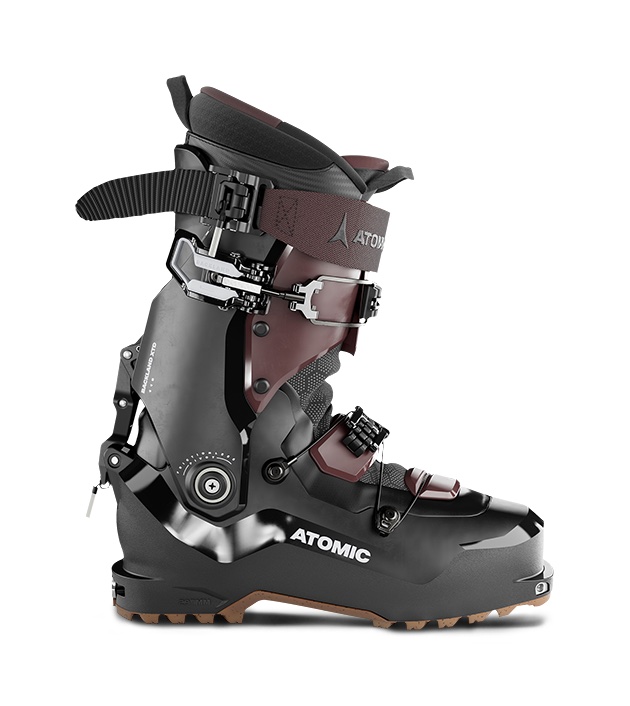
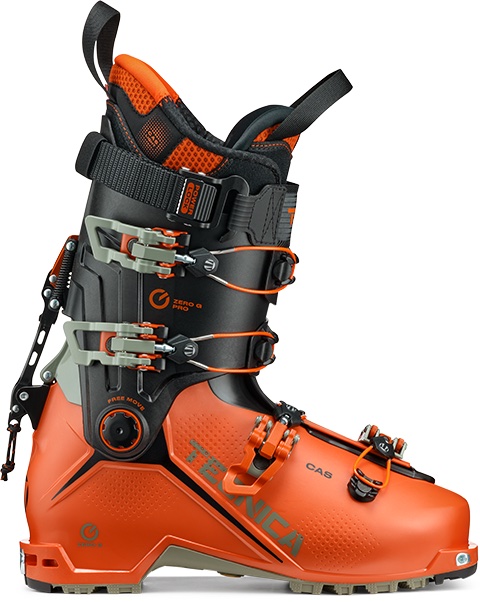
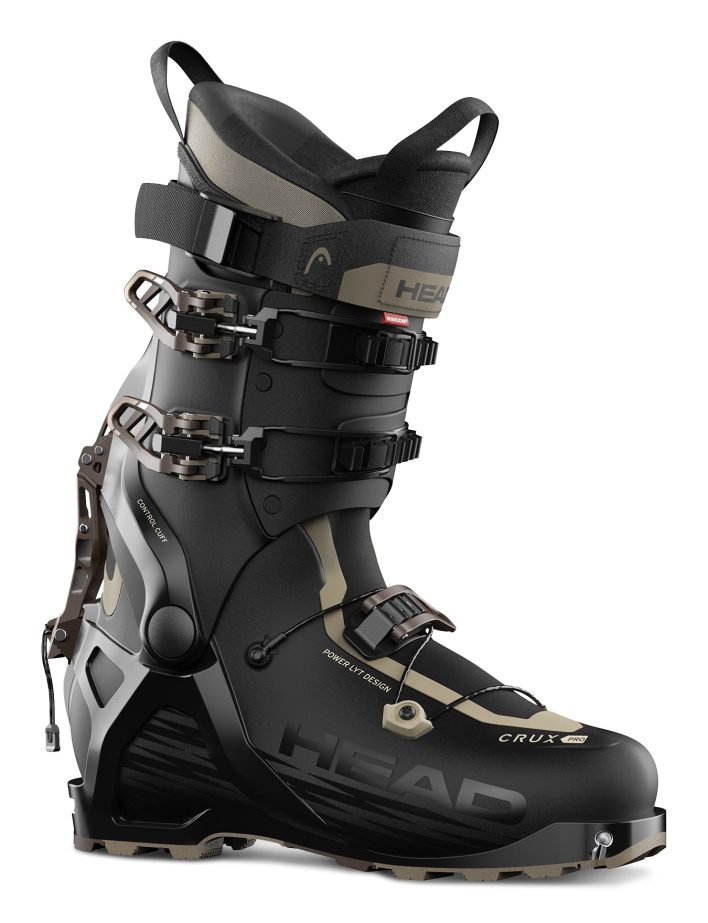
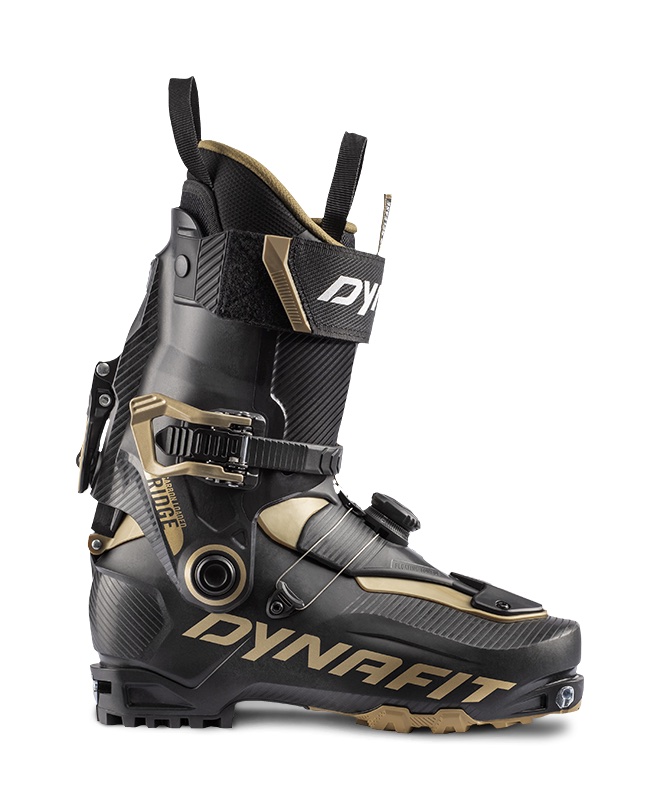
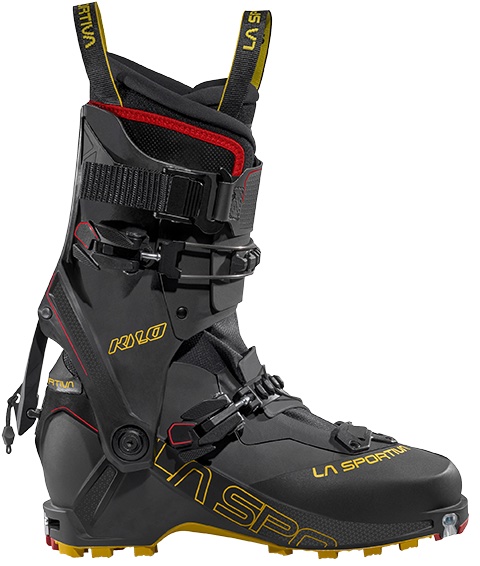









Related posts:
Weston Japow Splitboard
Völkl Mantra V.Werks Skis
2017 Editors' Choice Awards: Splitboards
2015 Editors’ Choice Awards: Boots